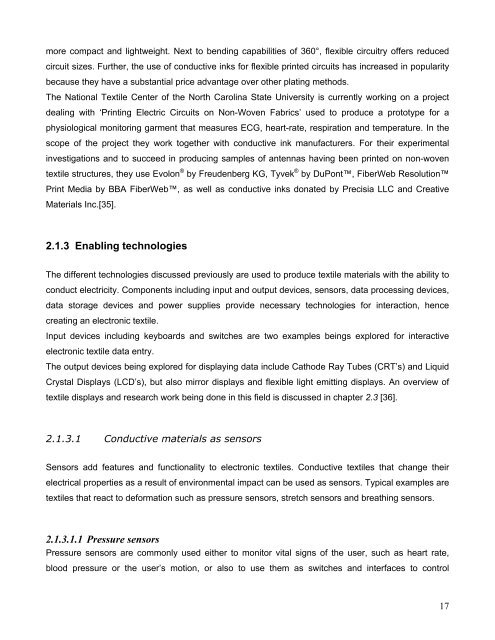Clevertex - Grado Zero Espace Srl
Clevertex - Grado Zero Espace Srl
Clevertex - Grado Zero Espace Srl
You also want an ePaper? Increase the reach of your titles
YUMPU automatically turns print PDFs into web optimized ePapers that Google loves.
more compact and lightweight. Next to bending capabilities of 360°, flexible circuitry offers reduced<br />
circuit sizes. Further, the use of conductive inks for flexible printed circuits has increased in popularity<br />
because they have a substantial price advantage over other plating methods.<br />
The National Textile Center of the North Carolina State University is currently working on a project<br />
dealing with ‘Printing Electric Circuits on Non-Woven Fabrics’ used to produce a prototype for a<br />
physiological monitoring garment that measures ECG, heart-rate, respiration and temperature. In the<br />
scope of the project they work together with conductive ink manufacturers. For their experimental<br />
investigations and to succeed in producing samples of antennas having been printed on non-woven<br />
textile structures, they use Evolon ® by Freudenberg KG, Tyvek ® by DuPont, FiberWeb Resolution<br />
Print Media by BBA FiberWeb, as well as conductive inks donated by Precisia LLC and Creative<br />
Materials Inc.[35].<br />
2.1.3 Enabling technologies<br />
The different technologies discussed previously are used to produce textile materials with the ability to<br />
conduct electricity. Components including input and output devices, sensors, data processing devices,<br />
data storage devices and power supplies provide necessary technologies for interaction, hence<br />
creating an electronic textile.<br />
Input devices including keyboards and switches are two examples beings explored for interactive<br />
electronic textile data entry.<br />
The output devices being explored for displaying data include Cathode Ray Tubes (CRT’s) and Liquid<br />
Crystal Displays (LCD’s), but also mirror displays and flexible light emitting displays. An overview of<br />
textile displays and research work being done in this field is discussed in chapter 2.3 [36].<br />
2.1.3.1 Conductive materials as sensors<br />
Sensors add features and functionality to electronic textiles. Conductive textiles that change their<br />
electrical properties as a result of environmental impact can be used as sensors. Typical examples are<br />
textiles that react to deformation such as pressure sensors, stretch sensors and breathing sensors.<br />
2.1.3.1.1 Pressure sensors<br />
Pressure sensors are commonly used either to monitor vital signs of the user, such as heart rate,<br />
blood pressure or the user’s motion, or also to use them as switches and interfaces to control<br />
17

















